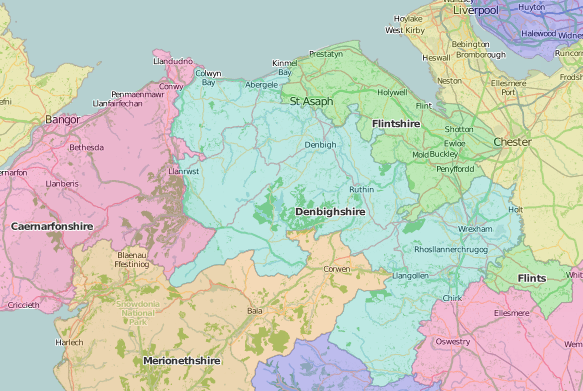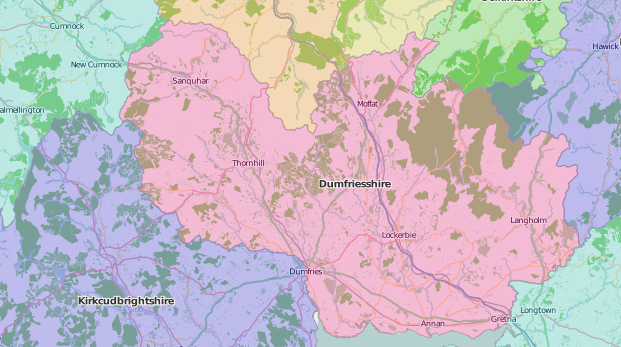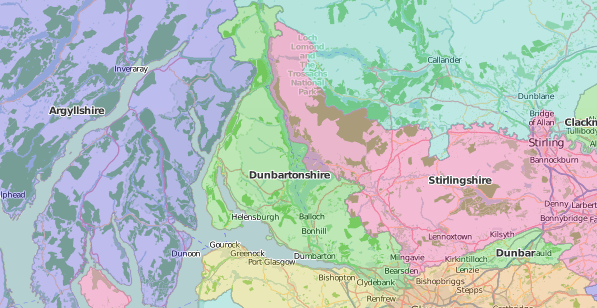
D is for Denbighshire, Dumfries and Dunbarton in this selection of County Lives.
Speed’s map of Denbighshire shows the trio of market towns, Denbigh, Ruthin, and Wrexham, well placed in the ‘beautiful and pleasant’ Vale of Clwyd. Visitors flocking there in the 19th century could take as their comprehensive guidebook William Davis’s Hand-book for the Vale of Clwyd; containing a topographical and historical description of the towns of Rhyl, Abergele, Saint Asaph, Denbigh, and Ruthin; with all the adjacent villages, castles, mansions, churches, monuments, antiquities, picturesque scenery, and every object of attraction, etc. Compiled from authentic sources and personal observation, as a general guide for the information of visitors and residents (1856). Further south, Llangollen was already a popular destination, with guidebooks including Wilfrid Tord Simpson’s 1837 Account of the town and vale of Llangollen, including, in a circuit of about seven miles, those objects most worthy of the notice of persons visiting that romantic and interesting neighbourhood.
Denbighshire’s 19th century visitors could include the Eisteddfod in their tour: the 1820 Eisteddfod was held at Wrexham (The Eisteddfod poems were published in Denbigh, as Powysion; sef Odlau ac Ynglynion .. Eisteddfod Gwrecsam, 1820. Dinbych. 1821); two were held at Denbigh in 1824 and 1828 (The Gwyneddion; or, an Account of the Royal Denbigh Eisteddford held in September, 1828; together with the prize essays and poems) and later Eisteddfoddau were held at Llangollen (1858), Denbigh (1860), and Ruthin (1868).
With no Eisteddfod in Llanrwst until 1951, John Williams, Lecturer of Llanwrst (1760-1826) would have had to travel, or time travel, to attend the gathering. Williams is known to Special Collections from his book label and inscription in Thomas Bisse’s Prydferthwch sancteiddrwydd yn y weddi gyffredin [Beauty of holiness in the common prayer], 1722. There were at least seventeen editions of Bisse’s very popular work from 1716 to 1846, but only one in Welsh, of which ours is the least-travelled of the four copies known worldwide: in London, Oxford, Harvard and Liverpool. Bisse is remembered as the founder of the Three Choirs Festival, of Hereford, Gloucester, and Worcester cathedrals.

George Chapman (1723-1806), a “very eminent and successful” teacher in Dumfries for nearly 30 years, was renowned for his reforming educational methods, published as, A treatise on education, in two parts, with the author’s method of instruction while he taught the school of Dumfries, and a view of other books on education (1790). The first edition (1773) was followed by four more up to 1792, with detailed instructions for teaching, and growing lists of reviews of other educational works. His obituary in the Gentleman’s Magazine declares, “He zealously devoted himself to the communication of useful knowledge to almost the last day of his life”.

Spelling is an issue in Dunbartonshire, which has switched between Dunbarton and Dumbarton at different periods. It appears in both forms in the Statistical Accounts of Scotland. The county town, however, is always with an ‘m’, as in ‘the Cross at Dumbarton’ – the place of publication of Joseph Irving’s Lennox garland; gleaned from divers fields of Scottish poesy (1860). Donbritoun and Lenox both appear on Speed’s map of Scotland, by the southern shore of Loch Lomond.
Special Collections classmarks:
Denbighshire
- William Davis, Hand-book for the Vale of Clwyd; containing a topographical and historical description of the towns of Rhyl, Abergele, Saint Asaph, Denbigh, and Ruthin; with all the adjacent villages, castles, mansions, churches, monuments, antiquities, picturesque scenery, and every object of attraction, etc. Compiled from authentic sources and personal observation, as a general guide for the information of visitors and residents (Ruthin, 1856: SPEC Y85.3.109)
- Wilfrid Tord Simpson, Account of the town and vale of Llangollen, including, in a circuit of about seven miles, those objects most worthy of the notice of persons visiting that romantic and interesting neighbourhood (1837: Y83.3.299)
- Eisteddfod Gwrecsam, Wrexham, 1820, Powysion; sef Odlau ac Ynglynion … Eisteddfod Gwrecsam, 1820 (Dinbych [Denbigh] 1821: SPEC Y82.3.1838)
- Eisteddfod Genedlaethol Cymru (1828 : Denbigh, Wales), The Gwyneddion; or, an Account of the Royal Denbigh Eisteddford held in September, 1828; together with the prize essays and poems (Chester, 1830: SPEC Y83.3.210)
- Thomas Bisse’s Prydferthwch sancteiddrwydd yn y weddi gyffredin [Beauty of holiness in the common prayer] (1722: SPEC G53.10)
Dumfries
- George Chapman (1723-1806), A treatise on education, in two parts, with the author’s method of instruction while he taught the school of Dumfries, and a view of other books on education … (London : published for the author, and sold by the booksellers in town and country, 1790: SPEC Y79.3.1131/1115)
Dunbartonshire
- A Lennox garland; gleaned from divers fields of Scottish poesy (Printed for J.I. [Joseph Irving], at the Cross of Dumbarton, 1860: SPEC FRASER 1665)
Map of Denbighshire from Wikishire.co.uk CC-BY-SA